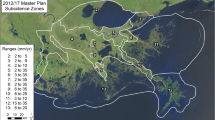Summary
Land Subsidence Along Delta-Mendota Canal, California
The Delta-Mendota Canal in the northwestern quarter of the San Joaquin Valley is about 113 miles (182 km) long, 100 feet (30 m) wide, and 16 feet (5 m) deep. The canal is mostly concrete-lined, and has a design gradient of about 3 inches per mile. Approximately 40 miles of the canal in its lower reach, downstream from Mile Post 75, are located in an area affected by so-called “deep” land subsidence. The phenomenon was not recognized during the construction and was not taken into consideration in the design. From May 1953 to February 1966, subsidence along the canal locally exceeded 5–6 feet. As a result, concrete lining, pipe crossings, bridges, and other structures became flooded and locally completely submerged.
This subsidence is caused essentially by an irrigation overdraft of the confined ground water. Due to the overdraft from 1905 to 1953, decline of piezometric levels along the alinement varied from 90 to 200 feet. With canal water delivery in 1951–1953, the overdraft virtually ceased. Present subsidence is, therefore, essentially a progressively diminishing “lag” inherited from past overdraft. Active subsidence in neighboring areas, where overdraft is still present, may also affect the canal.
Ultimate amounts of lag were recently calculated from past subsidence records of individual bench marks established in 1953 using the exponential decay equation:
, wherey = subsidence after 1953,t = time (in years) after 1953,A, B = unknown coefficients,Z = ultimate subsidence after 1953.
The obtained values varied from traces to 8.25 feet.
Zusammenfassung
Die Bodensenkung entlang des Delta-Mendota-Kanals in Kalifornien
Der Delta-Mendota-Kanal im San-Joaquin-Tal ist ungefähr 182 km lang, 30 m breit und 5 m tief. Er ist größtenteils betoniert und hat ein durchschnittliches Gefälle von etwa 4 cm/km. Ungefähr 72 km des Kanals liegen in dem Gebiet von Bodensenkungen. Das Phänomen war während des Kanalbaues nicht erkannt worden und wurde deshalb nicht in Betracht gezogen. Zwischen Mai 1953 und Februar 1966 betrug die Bodensenkung entlang des Kanals örtlich über 1,5 bis 2 m, wodurch Betonbedeckung, Brücken, Rohrkreuzungen und andere Anlagen teilweise versanken oder gänzlich überschwemmt worden sind.
Die Bodensenkung ist durch übermäßiges Auspumpen artesischen Grundwassers für Bewässerungen hervorgerufen worden. Die Auspumpung in den Jahren 1905 bis 1953 hat den artesischen Wasserspiegel entlang des Kanals bis zu 60 m erniedrigt. Der Kanalbau wurde im Jahre 1951 beendet. Mit der Benützung des Kanals während der Jahre 1951 bis 1953 wurde die übermäßige Auspumpung beendigt. Deswegen ist die gegenwärtige, sich allmählich vermindernde Bodensenkung ein passiver (relikter) Prozeß, der als Erbteil von einer früheren „aktiven“ Bodensenkung zurückblieb. (Der Kanal ist möglicherweise auch von aktiven Bodensenkungen in der Umgebung beeinflußt, wo das übermäßige Auspumpen weitergeht.) Zukünftige endgültige Werte der Bodensenkung wurden aufgrund von Nivellierungen entlang des Kanals und von Exponentialgleichungen kalkuliert:
, woriny = Bodensenkung nach dem Jahre 1953,t = Zeit (Jahre) nach dem Jahre 1953,A, B = unbekannte Konstante,Z = Bodensenkung nach dem Jahre 1953.
Die Ergebnisse variieren von geringen Beträgen bis etwa 2,7 m.
Résumé
Affaissements du sol le long du Canal “Delta-Mendota”, en Californie
Le Canal Delta-Mendota est situé dans le quart nord-ouest du vallon San Joaquin, il a approximativement 182 km de longueur, 30 m de largeur, et 5 m de profondeur. La plus grande partie du canal est revêtue de béton, et a une pente de 4 cm/km. Près de 72 km du canal, à l'aval de la borne milliaire Nr. 75, sont situés dans la zone affectée par l'affaissement. Le phénomène n'était pas reconnu pendant la construction et n'avait pas été pris en considération dans l'étude du projet. De mai 1953 à février 1966, l'affaissement du terrain le long du canal excédait localement 1,5 à 2 m. Le résultat, c'est que les revêtements de béton, les ponts, les croisements de conduites, et diverses autres structures ont été partiellement submergés ou entièrement inondés.
L'affaissement est causé essentiellement par le pompage excessif de l'eau artésienne pour l'irrigation. Le pompage durant les années 1905–1953 a abaissé le niveau de l'eau de 30 à 60 m. La construction du canal a été terminée en 1951. Avec l'utilisation de l'eau du canal, durant les années 1951–1953, le pompage excessif a pris fin. L'affaissement actuel n'est qu'une “queue” du processus ancien en progessive diminution.
Il est possible que le canal soit aussi affecté par l'affaissement de zones où un pompage excessif continue.
La valeur finale de l'affaissement a été calculée en utilisant les valeurs de l'affaissement de repères installés le long du canal en 1953, et des fonctions décroissantes exponentielles:
oùy = affaissement après 1953,t = temps (années) après 1953,A, B = constantes inconnues,Z = affaissement final après 1953.
Les valeurs obtenues varient de presque 0 jusqu'à 2,7 m.
Similar content being viewed by others
References
Frink, J. W., and H. A. Kues: Corcoran Clay — A Pleistocene Lacustrine Deposit in San Joaquin Valley, California. Am. Assoc. Petroleum Geologists Bull., Vol. 38, pp. 2357–2371, 1954.
Gibbs, H. J.: A Laboratory Testing Study of Land Subsidence. The 1st Pan American Soil Conference on Soil Mechanic Proc., 1959, Mexico City, Vol. I, pp. 13–36, 1960.
Miller, R. E.: Compaction of an Aquifer System Computed From Consolidation Tests and Decline Head. USGS Prof. Paper 424B, pp. B54-B58, 1961.
USBR: Technical Record of Design and Construction, Delta-Mendota Canal, Central Valley Project, California. U. S. Bureau of Reclamation, Denver, Colorado, 1959.
USBR: Central Valley Project, Reclamation Project Data. U. S. Government Printing Office, Washington, D. C., pp. 92–112, 1961.
Author information
Authors and Affiliations
Additional information
With 8 Figures
Rights and permissions
About this article
Cite this article
Prokopovich, N.P. Land subsidence along Delta-Mendota Canal, California. Rock Mechanics 1, 134–144 (1969). https://doi.org/10.1007/BF01241506
Received:
Issue Date:
DOI: https://doi.org/10.1007/BF01241506




